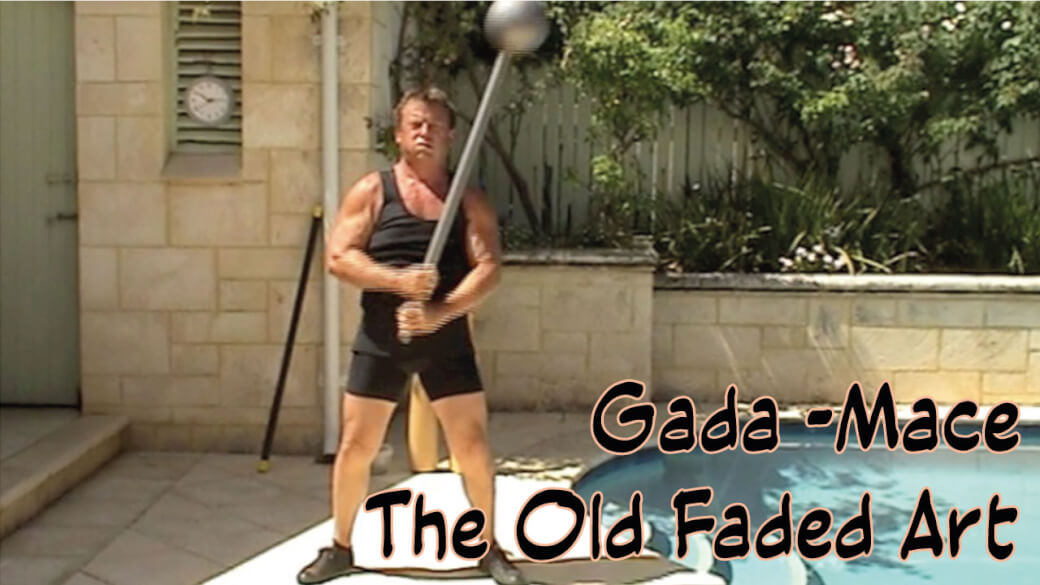Gada Mace the Old Faded Art
‘ 한국어 번역 ‘
The gada mace was a weapon that was swung in battle, in mythology it was used to combat the devil. The forces a gada generates are awesome, the only way to experience this power is to learn the old faded art of how to swing a gada.
The Gada in this video weighs 12 kilos
Personal Safety
Your first gada swings should be done outside in parks, grassed areas, sandy beaches no CHILDREN, no PETS, as you may need to drop the gada.
Warm-up 360’s
The 360 is the basic movement, so to start my hands are right over left, it is an asymmetric grip.
One Minute Method
I’m also facing a clock and using the sweep hand, swinging anti-clockwise every five seconds for the duration of one minute. When the first minute finished, change direction and swing clockwise for the second minute.
For complete dexterity, minute three means a hand change left over right and swing clockwise, minute four swing anti-clockwise. So two different grips and two minutes each way, good warm-up, focusing on form, mindful movement and plenty of variety to think about.
Choke the Gada Mace
If you find a swing every five seconds too much, try one every ten seconds. You can also choke the gada, by moving your hands halfway down the shaft, this makes the gada easier to handle. If you need more information on choking, please have a look at my video called Mace Swinging Tutorial – How to do 360’s.
This discipline teaches and reinforces the control and balance of the gada, the idea is to complete the swing, hold still and refocus. Total control of something that is difficult to handle. Maintaining a steady rhythm will increase muscle endurance and provide an intense workout.
Push and Pull Technique
The push and pull taxes the whole upper body, you are using momentum and you are fighting it. The push is upward and slightly to the side, the intention is to make the gada fall, as the descent begins you have to brace your core, shoulders automatically will quarter turn with the momentum, the pull has to start just before the gada reaches the lowest point. Harness the force with your shoulders, pull up turning a quarter turn in the opposite direction as you bring the gada to the resting position at the front.
10 to 2’s
The difference between 360s and 10 to 2’s is that 10 to 2’s demand non-stop movement.
This means that you have to conquer 360’s first.
Practising 360’s as described will set you up for 10 to 2’s I am about to describe.
360s
Perform 2×360’s, one each way, putting them together creates a 10 to 2.
The swing technique is therefore the same as 360s.
When you bring the gada to the front, the head has to stop and float over your shoulder, your arms complete the pull-down and immediately start pushing upward, the rest period is therefore shorter.
Tempo
Try to find a comfortable tempo, if you find yourself speeding up slow down, even STOP at the front and REFOCUS
Front View
Elbows up, absorb the falling weight with your shoulders and knees.
Back View
Even though the grip is asymmetric, concentrate on letting the gada pull your arms down when the gada is behind you, your elbows should be up
Endurance
Your hands & forearms are going to fail first
Do sets of 10 or less
Then do something else and come back and do some more swings
As you become stronger go for a minute non-stop and keep adding 30 seconds at a time
More Push and Pull Technique
Be warned, the PULL is underestimated by everyone trying this for the first time you have to PULL VERY HARD repeat PULL VERY HARD, to raise the gada head over the shoulder, straighten your arms in front pulling down, this will help to steady the gada, the shaft should always be close to your body. The pull-down gives an opportunity to rest, relax your grip, before starting the next swing.
Grip
To begin with, you will hold the Mace shaft with a tight grip. Once you get more proficient you will learn to relax your grip. There are two places you can do this.
- At the end of the front PULL down, keep the gada shaft is close to the body for stability.
- When your hands are behind your head as you start the PULL up.
270’s
The 270 is a three-quarter circle performed clockwise and anti-clockwise, you have pushed the gada over your shoulder, and as the gada is starting to come up on the other side you stop the pull, bring the gada to shoulder height and start reversing the movement, now the core has to work really hard, there is little downward force to harness, the pull has to be massive to bring the gada to the front resting position.
Foot Positions
270’s need a wider stance to secure more stability, you are dealing with massive centrifugal forces, a good way to find the sweet spot is to perform pendulum swings behind you and adjust your foot position so that you have a solid footing.
Double 270’s
The double 270s have an additional swing, the difference is that you stop the pull on both sides, performing a pendulum swing at the back, after the second stop the core has to excel and bring the gada to the front resting position with massive force.
Breathing
Take a three-quarter breath in as you push up because your chest is opening up, this helps to pressurise your core, release small bursts of air out during the movement, and exhale when the gada is at the front resting position, your chest cavity is contracted at this point.
720’s
The 720 is a combination move starting with half of a standard 360,
when the gada head descends to the lowest point of the swing, pull hard, and perform a high 360,
your hands should rotate around your head, you are scribing a much tighter circle and the gada is travelling much faster,
prepare to slow down the momentum and complete the last half circle to finish in the front resting position.
Gada Mace the Old Faded Art is an ancient training method, certainly not for the faint-hearted.




Hi Taras.
A very good point about safety and pets. I noticed that a very prominent teacher of kettle bell technique seems to regularly post videos on YouTube showing himself demonstrating heavy kettle bell move with his pet dogs wandering around close to him. Not only dangerous to the dogs but the chance of distraction and even a pet knocking into you could cause personal injury. Not good practice.
Regards
http://blog.naver.com/park6967/220920329278
Your Article was translated into Korean.